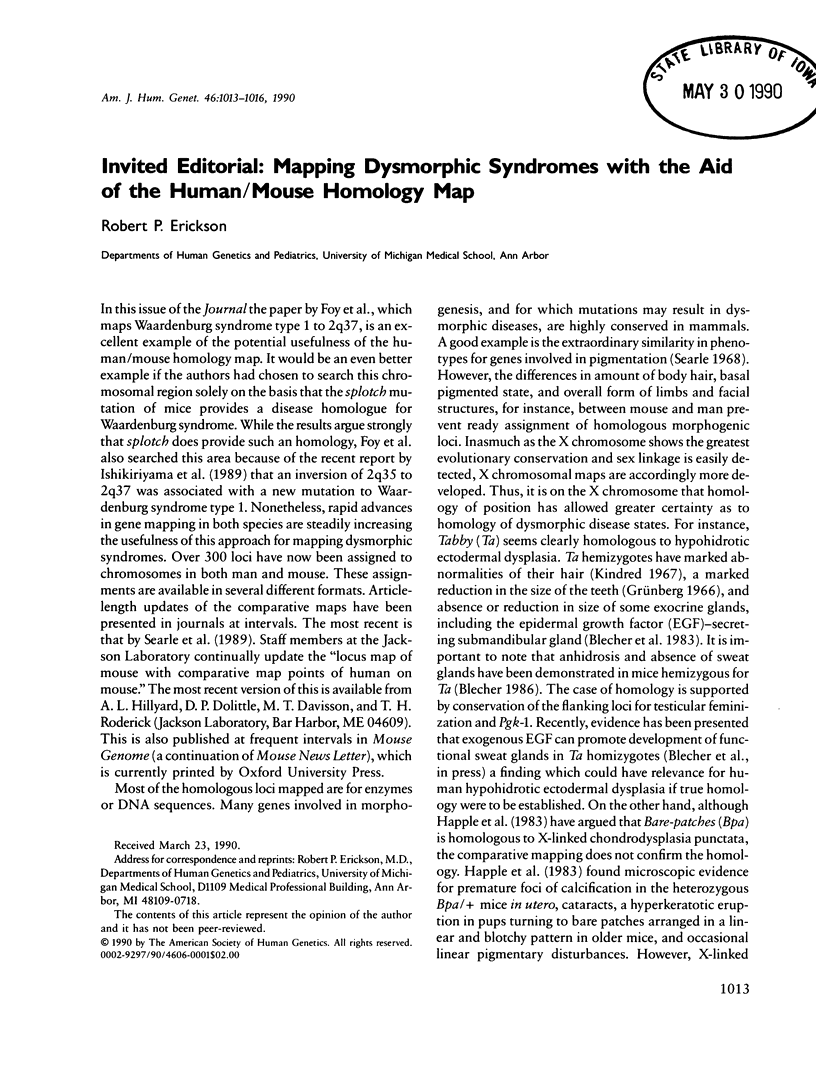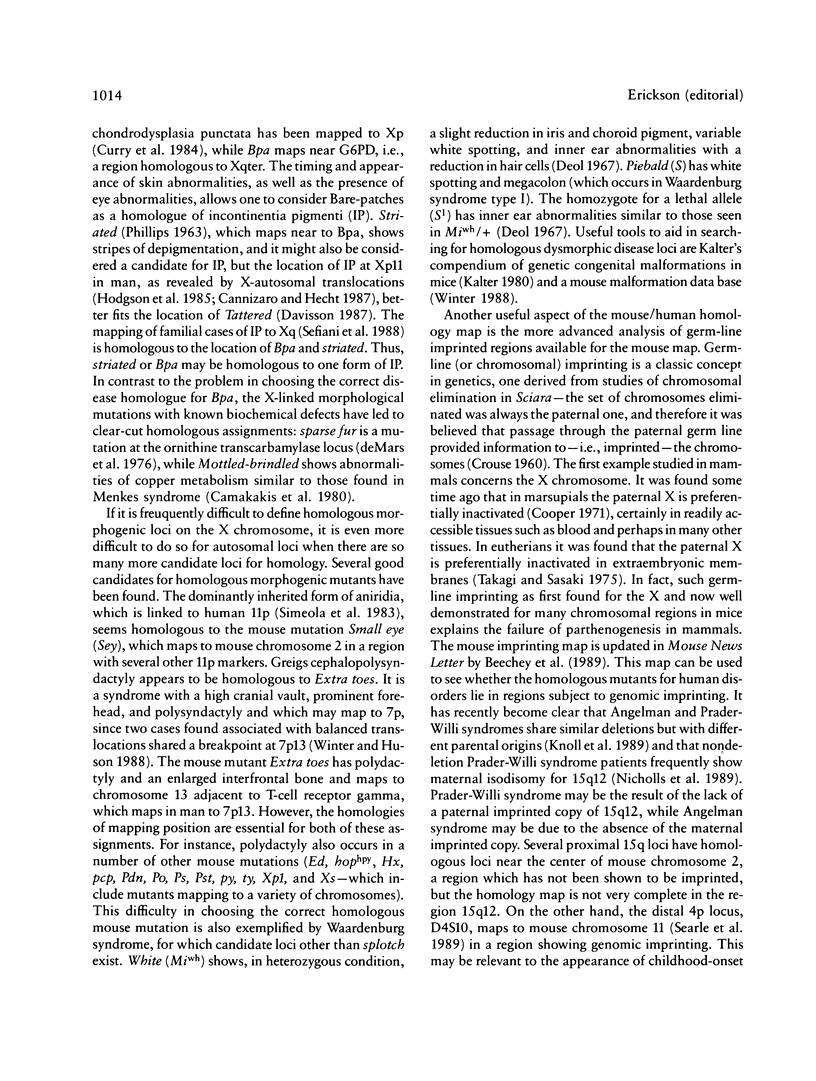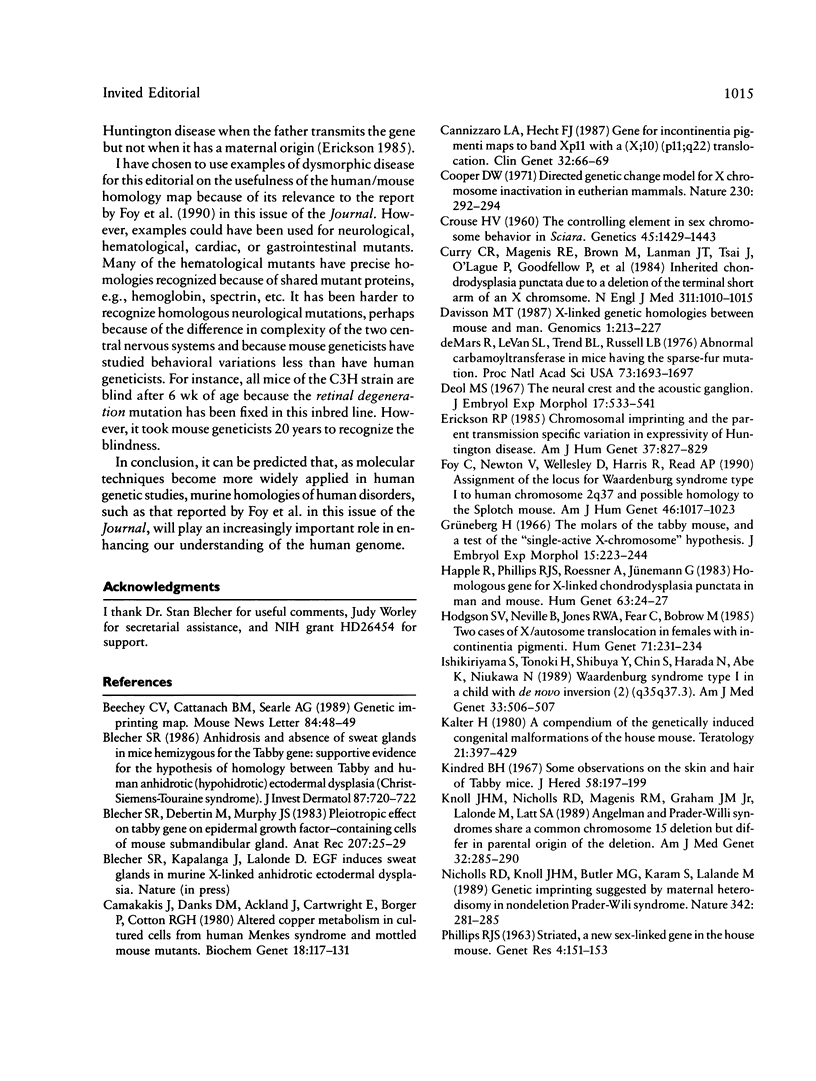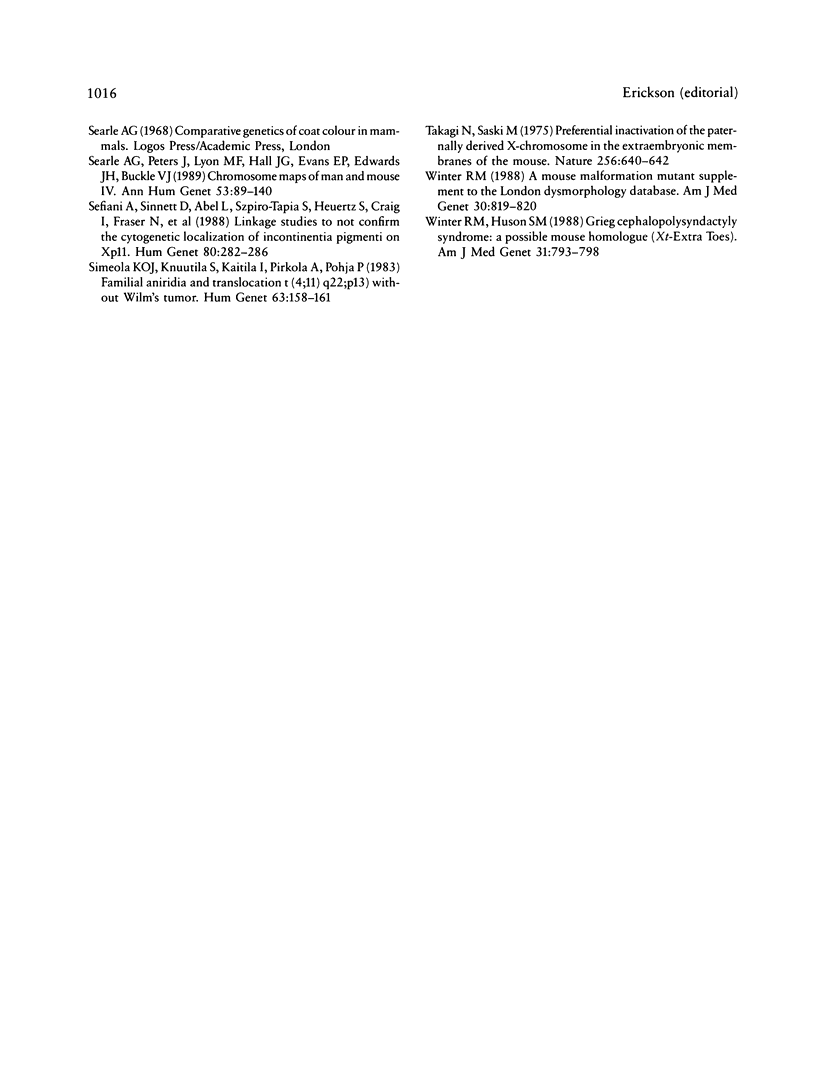Full text
PDF



Selected References
These references are in PubMed. This may not be the complete list of references from this article.
- Blecher S. R. Anhidrosis and absence of sweat glands in mice hemizygous for the Tabby gene: supportive evidence for the hypothesis of homology between Tabby and human anhidrotic (hypohidrotic) ectodermal dysplasia (Christ-Siemens-Touraine syndrome). J Invest Dermatol. 1986 Dec;87(6):720–722. doi: 10.1111/1523-1747.ep12456718. [DOI] [PubMed] [Google Scholar]
- Blecher S. R., Debertin M., Murphy J. S. Pleiotropic effect of Tabby gene on epidermal growth factor-containing cells of mouse submandibular gland. Anat Rec. 1983 Sep;207(1):25–29. doi: 10.1002/ar.1092070104. [DOI] [PubMed] [Google Scholar]
- Camakaris J., Danks D. M., Ackland L., Cartwright E., Borger P., Cotton R. G. Altered copper metabolism in cultured cells from human Menkes' syndrome and mottled mouse mutants. Biochem Genet. 1980 Feb;18(1-2):117–131. doi: 10.1007/BF00504364. [DOI] [PubMed] [Google Scholar]
- Cannizzaro L. A., Hecht F. Gene for incontinentia pigmenti maps to band Xp11 with an (X;10) (p11;q22) translocation. Clin Genet. 1987 Jul;32(1):66–69. doi: 10.1111/j.1399-0004.1987.tb03326.x. [DOI] [PubMed] [Google Scholar]
- Cooper D. W. Directed genetic change model for X chromosome inactivation in eutherian mammals. Nature. 1971 Apr 2;230(5292):292–294. doi: 10.1038/230292a0. [DOI] [PubMed] [Google Scholar]
- Crouse H V. The Controlling Element in Sex Chromosome Behavior in Sciara. Genetics. 1960 Oct;45(10):1429–1443. doi: 10.1093/genetics/45.10.1429. [DOI] [PMC free article] [PubMed] [Google Scholar]
- Curry C. J., Magenis R. E., Brown M., Lanman J. T., Jr, Tsai J., O'Lague P., Goodfellow P., Mohandas T., Bergner E. A., Shapiro L. J. Inherited chondrodysplasia punctata due to a deletion of the terminal short arm of an X chromosome. N Engl J Med. 1984 Oct 18;311(16):1010–1015. doi: 10.1056/NEJM198410183111603. [DOI] [PubMed] [Google Scholar]
- Davisson M. T. X-linked genetic homologies between mouse and man. Genomics. 1987 Nov;1(3):213–227. doi: 10.1016/0888-7543(87)90047-4. [DOI] [PubMed] [Google Scholar]
- DeMars R., LeVan S. L., Trend B. L., Russell L. B. Abnormal ornithine carbamoyltransferase in mice having the sparse-fur mutation. Proc Natl Acad Sci U S A. 1976 May;73(5):1693–1697. doi: 10.1073/pnas.73.5.1693. [DOI] [PMC free article] [PubMed] [Google Scholar]
- Deol M. S. The neural crest and the acoustic ganglion. J Embryol Exp Morphol. 1967 Jun;17(3):533–541. [PubMed] [Google Scholar]
- Erickson R. P. Chromosomal imprinting and the parent transmission specific variation in expressivity of Huntington disease. Am J Hum Genet. 1985 Jul;37(4):827–829. [PMC free article] [PubMed] [Google Scholar]
- Foy C., Newton V., Wellesley D., Harris R., Read A. P. Assignment of the locus for Waardenburg syndrome type I to human chromosome 2q37 and possible homology to the Splotch mouse. Am J Hum Genet. 1990 Jun;46(6):1017–1023. [PMC free article] [PubMed] [Google Scholar]
- Grüneberg H. The molars of the tabby mouse, and a test of the 'single-active X-chromosome' hypothesis. J Embryol Exp Morphol. 1966 Apr;15(2):223–244. [PubMed] [Google Scholar]
- Happle R., Phillips R. J., Roessner A., Jünemann G. Homologous genes for X-linked chondrodysplasia punctata in man and mouse. Hum Genet. 1983;63(1):24–27. doi: 10.1007/BF00285392. [DOI] [PubMed] [Google Scholar]
- Hodgson S. V., Neville B., Jones R. W., Fear C., Bobrow M. Two cases of X/autosome translocation in females with incontinentia pigmenti. Hum Genet. 1985;71(3):231–234. doi: 10.1007/BF00284581. [DOI] [PubMed] [Google Scholar]
- Ishikiriyama S., Tonoki H., Shibuya Y., Chin S., Harada N., Abe K., Niikawa N. Waardenburg syndrome type I in a child with de novo inversion (2)(q35q37.3). Am J Med Genet. 1989 Aug;33(4):505–507. doi: 10.1002/ajmg.1320330419. [DOI] [PubMed] [Google Scholar]
- Kalter H. A compendium of the genetically induced congenital malformations of the house mouse. Teratology. 1980 Jun;21(3):397–429. doi: 10.1002/tera.1420210317. [DOI] [PubMed] [Google Scholar]
- Knoll J. H., Nicholls R. D., Magenis R. E., Graham J. M., Jr, Lalande M., Latt S. A. Angelman and Prader-Willi syndromes share a common chromosome 15 deletion but differ in parental origin of the deletion. Am J Med Genet. 1989 Feb;32(2):285–290. doi: 10.1002/ajmg.1320320235. [DOI] [PubMed] [Google Scholar]
- Nicholls R. D., Knoll J. H., Butler M. G., Karam S., Lalande M. Genetic imprinting suggested by maternal heterodisomy in nondeletion Prader-Willi syndrome. Nature. 1989 Nov 16;342(6247):281–285. doi: 10.1038/342281a0. [DOI] [PMC free article] [PubMed] [Google Scholar]
- Searle A. G., Peters J., Lyon M. F., Hall J. G., Evans E. P., Edwards J. H., Buckle V. J. Chromosome maps of man and mouse. IV. Ann Hum Genet. 1989 May;53(Pt 2):89–140. doi: 10.1111/j.1469-1809.1989.tb01777.x. [DOI] [PubMed] [Google Scholar]
- Sefiani A., Sinnett D., Abel L., Szpiro-Tapia S., Heuertz S., Craig I., Fraser N., Kruse T. A., Frydman M., Peter M. O. Linkage studies do not confirm the cytogenetic location of incontinentia pigmenti on Xp11. Hum Genet. 1988 Nov;80(3):282–286. doi: 10.1007/BF01790098. [DOI] [PubMed] [Google Scholar]
- Simola K. O., Knuutila S., Kaitila I., Pirkola A., Pohja P. Familial aniridia and translocation t(4;11)(q22;p13) without Wilms' tumor. Hum Genet. 1983;63(2):158–161. doi: 10.1007/BF00291536. [DOI] [PubMed] [Google Scholar]
- Takagi N., Sasaki M. Preferential inactivation of the paternally derived X chromosome in the extraembryonic membranes of the mouse. Nature. 1975 Aug 21;256(5519):640–642. doi: 10.1038/256640a0. [DOI] [PubMed] [Google Scholar]
- Winter R. M. A mouse malformation mutant supplement to the London Dysmorphology Database. Am J Med Genet. 1988 Jul;30(3):819–820. doi: 10.1002/ajmg.1320300315. [DOI] [PubMed] [Google Scholar]
- Winter R. M., Huson S. M. Greig cephalopolysyndactyly syndrome: a possible mouse homologue (Xt-extra toes). Am J Med Genet. 1988 Dec;31(4):793–798. doi: 10.1002/ajmg.1320310411. [DOI] [PubMed] [Google Scholar]


